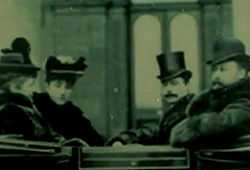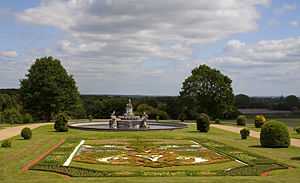Witley Court
Witley Court in Worcestershire, England is a Grade I listed building[1] and was once one of the great houses of the Midlands, but today it is a spectacular ruin after being devastated by fire in 1937. It was built by Thomas Foley in 1655 on the site of a former manor house near Great Witley. Subsequent additions were designed by John Nash in the early 19th century and the Court was subsequently bought by the Dudley family in 1837. The house and 40 acres were acquired in 2008 by a wealthy family for less than £0.9m, but remains in the guardianship of the Secretary of State for Culture, Media and Sport, and managed on their behalf by English Heritage since 1984.
History

The Lords Foley
The earliest building on the site was a Jacobean brick house constructed by the Russell family. After the Civil War the house was sold to Thomas Foley, an ironmaster. He erected two towers on the north side of the house and his grandson Thomas Foley, the 1st Lord Foley added the wings which enclose the entrance courtyard.
In 1735 the 2nd Lord Foley constructed a new parish church to the west of this courtyard, an undertaking begun by his father. The church was given a remarkable baroque interior in 1747 when he commissioned James Gibbs to incorporate paintings and furnishings acquired at the auction of the contents of Cannons House. This was the magnificent Middlesex home of the Duke of Chandos from where the artwork was shipped by canal to Great Witley.
In the second half of the 18th century the park was landscaped. This included sweeping away the village of Great Witley, which came too close to the south front (rear) of the house. The village was re-located to its present position.
In about 1805 the 3rd Lord employed John Nash to carry out a major reconstruction of the house, including the addition of huge ionic porticoes to the north and south fronts. The portico on the south front is probably the largest on any country house in England.
The Earls of Dudley
In 1837 serious debt forced the 4th Lord to sell the estate to the trustees of William, Lord Ward, later 1st Earl of Dudley, who had inherited a great fortune from the coal and iron industries in the Black Country.
From 1843 to 1846 Witley Court was lent to Queen Adelaide, the widow of King William IV, who required the pianos in the house to be tuned. A local man, who had recently moved from London to set up his own music dealership and piano-tuning business, was recommended. That man was William Elgar (Edward Elgar's father), who was then to display the royal warrant on his business stationery. Edward Elgar became a friend of the Dudley family thereafter because of his father's work at the house and would perform for them on the piano in the ballroom. Whilst at Witley Court she had two chaplains - Rev. John Ryle Wood, Canon of Worcester[2] and Rev. Thomas Pearson, Rector of Great Witley.[3]
In the 1850s, Lord Ward (the Earl of Dudley) engaged the architect Samuel Daukes, who had already altered his London house, Dudley House on Park Lane and the church at Great Witley, to remodel the house in Italianate style using ashlar stone cladding over the existing red brickwork. He also commissioned the garden designer William Andrews Nesfield to transform the gardens. This was Nesfield's 'Monster Work'.
In 1885 the 1st Earl of Dudley died and his son William Humble Ward the 2nd Earl of Dudley inherited the property. His wife was Rachel Ward, Countess of Dudley (née Rachel Gurney). The photos below show this couple and some of the parties that they held at Witley Court during the time that they owned it.
 |
 |
 |
| William Ward, 1st Earl of Dudley who bought Witley Court in 1837 | William Humble Ward, 2nd Earl of Dudley who inherited Witley Court when his father died in 1885 | Rachel, Countess of Dudley, wife of the 2nd Earl of Dudley. |
 |
 |
 |
| Garden Party in front of the Perseus and Andromeda fountain circa 1900 | A carriage outside Witley Court circa 1900. The couple on the far side are the 2nd Earl of Dudley and his wife Rachel. | Shooting party at Witley Court in 1894. The Prince of Wales is in the centre of the photo. The couple to the left of him are the Countess of Dudley (with the fur collar) and the 2nd Earl of Dudley (with the white cap) |
Sir Herbert Smith
In 1920 Witley Court was sold by the 2nd Earl to Sir Herbert Smith, a Kidderminster carpet manufacturer. Sir Herbert only kept on a skeleton staff to manage the house whilst they were away, and many areas were left unused. The property needed to be sold again following a major accidental fire in September 1937 due to the insurance company not paying out for the major damage. The fire started in the bakery, situated in the basement room of the now worst preserved tower whilst Sir Herbert was at another of his houses. The servants tried to put the fire out by the use of the ancient fire pump, which was connected to the fountain, but as this had not been maintained for many years, it failed to work. Thereafter the estate was broken up and auctioned, and with the exception of the church were allowed to fall into ruin. The mansion didn't realise the amount it was thought to be worth due to the nearing Second World War. Following the sale only one wing of the house was gutted by the fire of 1937, the rest was almost intact. The house was bought by scrap dealers who stripped what they could from the structure of the house, leaving it in complete ruins. In 1972 the remnants of the house and garden (excluding the church) were taken into care by the government, via a compulsory guardianship order. Almost 70 years after the devastation, its ruins are still spectacular, and today the property is in the care of English Heritage. Great Witley Church, which is attached to the ruins, survived the fire, and so visitors can still view the paintings.
 |
 |
 |
| The fire at Witley Court in 1937. View from the front of the house | Witley Court fire in 1937. View from the side looking over the East Parterre Garden | View of fire from above Witley Court |
Restoration

The two immense fountains have survived. They were designed by Nesfield and executed by James[4] and William Forsyth,[5] who were carrying out sculpture in the house and the church. The largest, the Perseus and Andromeda Fountain, has been restored to working order by English Heritage.[6] For working times, see the Witley Court English Heritage website (link below). The remnants of Nesfield's magnificent parterres can also be seen.
In 2003 Witley Court's owners, the Wigington family of Stratford-upon-Avon, who had acquired it in 1953 for £20,000, placed the freehold for sale on Internet auction site eBay for £975,000. However, the arrangement with English Heritage would remain unchanged, irrespective of any change in ownership regardless of who buys the site, and Witley Court would continue to be a visitor attraction.[7] Witley was re-launched for sale in 2008 and sold for less than £0.9m to a wealthy family.[8]
In more recent times, the original plans and designs for the formal gardens have been discovered, and are in the process of being restored. The main area of the gardens, the South Parterre, between the house and the Perseus and Andromeda fountain, has already been completed. Meanwhile, work is ongoing on the East Parterre region.
A video made in 1967 by the band Procol Harum used Witley Court as the location. At this time the Witley Court site was completely derelict. The video link is given below under "External Links". The enormous difference that the restoration work has made can be estimated from this 1967 video.
-

Full view of the now fully operational Perseus and Andromeda fountain
-
One of the two stone temples in the formal gardens
-
View from within the Orangery
-
Inside the vast gutted ballroom
-
A scarce piece of surviving Carton Pierre plasterwork (a form of papier-mâché) in the Staircase Hall


 |
 |
 |
| Close view of the Flora Fountain circa 1900 before it was damaged | The East Parterre Garden circa 1900 showing the Flora Fountain undamaged | The East Parterre Garden today showing the damaged Flora Fountain. |
 |
 |
| The Perseus and Andromeda fountain, at Witley Court in 1897 when Lady Rachel Dudley and the 2nd Earl of Dudley were in residence. | The Perseus and Andromeda fountain today looking very much as it did when Witley Court was a residence. |
 |
 |
 |
 |
| Witley Court 1897 showing the gates which formed the entrance to the South part of the garden. | A closer view of the gates which were the entrance to the south garden | These gates still exist and are now the entrance to the London Bridge site in Lake Havasu City in the USA | Another view of the gates in Lake Havasu City. At the top of the gates the date 1862 can be seen which is when Nesfield completed the Witley Court gardens. |
References
- ↑ Historic England. "Witley Court and link to church of St Michael (Grade I) (1082656)". National Heritage List for England. Retrieved 1 October 2013.
- ↑ Wardle, Terry Heroes & Villains of Worcestershire 2010 The History Press p9
- ↑ Wardle, Terry Heroes & Villains of Worcestershire 2010 The History Press p108
- ↑ James Forsyth (1827 - 1910)
- ↑ Witley Court, a Grand Ruin in Worcestershire
- ↑ Restoration of the "Perseus and Andromeda" Fountain
- ↑ Worcestershire Archives. retrieved 3 July 2009
- ↑ Express and Star, Mystery buyer for old home, December 17, 2008 retrieved 14 January 2014
External links
| Wikimedia Commons has media related to Witley Court. |
- English Heritage
- Great Witley Church's official site
- 1967 video of Witley Court by Procol Harum This video shows Witley Court in a derelict state and illustrates the enormous difference that the restoration work has made.
- "Stately in Abandonment: Witley Court." Sometimes Interesting. 07 Aug 2014



